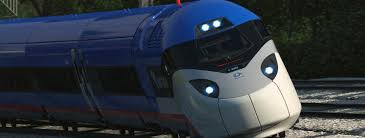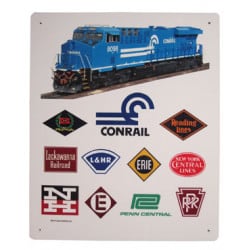PHOTO COURTESY OF CSX
FreightWaves is providing a forum – Market Voices – for a number of market experts.
Jim Blaze is a railroad career economist with an engineering background and a strategic analysis outlook. Jim’s career spans 21 years with Consolidated Rail Corporation (CONRAIL), 17 years with the rail engineering firm Zeta Tech Associates, 7 years with the State of Illinois Department of Transportation in Chicago urban goods movement research, and two years studying what to do with the seven bankrupt and unrecognizable Northeast railroads at the federal agency USRA. Now primarily a teacher and writer, Jim likes to focus on contrarian aspects of the railroad industry.
The railroad business models like Precision Scheduled Railroading might be the hot investment subject, but there is a longer-range investment possibility that I will review today. Consider the following. Railroads are a series of networked routes that constitute a long-run land investment portfolio.
The hypothesis is that “there is more to a strategic railway stock or debt instrument than just trains, tracks and railyards.”
Long after the last steel wheel railway freight train rolls down a steel rail track, the railway enterprise company might still be in business. Just not in exactly the same business.
Consider the following. Ever heard of the following companies: James Cotter’s Craig Corporation; Reading Entertainment; or the Citadel Holding Corporation?
The Reading Railroad
These companies all survived the creation of the freight railroad called Consolidated Rail Corporation (Conrail) in 1976 as real estate holdings from the bankrupt Reading Company.
A succession of investors or groups still do business today as the renamed Reading International Inc.
 IMAGE COURTESY OF READINGRAILROAD.ORG
IMAGE COURTESY OF READINGRAILROAD.ORG
 photo courtesy of the railroad museum of pennsylvania
photo courtesy of the railroad museum of pennsylvania
The genesis of the Reading Railroad goes back to 1833 with the charter of the Philadelphia & Reading Railroad. That evolved into the Reading Railroad through a series of build-outs and acquisitions of other rail companies.
In 1924 the Pennsylvania Reading Coal and Iron Railroad became an independent line and the Reading Railroad became the company’s operating name. It gradually expanded beyond the Schuylkill Valley area of Pennsylvania into New Jersey and into the New York City market via real estate leases or track use agreements with the Central of New Jersey Railroad. It eventually reached interchange locations with the major carriers like the New York Central Railroad and the Baltimore & Ohio Railroad.
U.S. railroading history is full of financial defaults. The Reading Railroad filed for bankruptcy three different times before it became relatively stable and profitable.
However, as the market use of anthracite coal declined in the 1950s, the Reading’s profits started to become losses by about 1961.
 PHOTO COURTESY OF READINGRAILROAD.ORG
PHOTO COURTESY OF READINGRAILROAD.ORG
Then, Reading rejuvenated its positive operating earnings with a series of creative changes and operational cost-cutting. One of the most innovative ideas during this time was the Bee-Line service. The Bee-line train innovation used shorter freight trains coupled with improved customer local plant switching services. The Reading would provide local train service to customers often when there were as few as five freight cars on a train.
Nonetheless, the bigger railroads in the Northeast like the Pennsylvania Railroad and the New York Central entered a period of traffic decline and financial losses between 1956 and 1970.
The 1970s – the creation of Amtrak and Conrail
 PHOTO COURTESY OF AMTRAK
PHOTO COURTESY OF AMTRAK
As passenger rail traffic declined with the advent of the interstate highway system and lower prices for airline travel, the federal government consolidated passenger rail service in the United States. The National Railroad Passenger Corporation (known as Amtrak) was created in 1970 to guarantee that passenger rail service survived.
At the same time, and for many reasons, the entire northeastern region of the U.S. became unsustainable for freight railroads. Once again, the U.S. government stepped in and consolidated the northeastern freight railroads into what became known as the Consolidated Rail Corporation (Conrail), including the Reading Railroad. This occurred on April 1, 1976.
A “skinny” Conrail
Conrail was the primary Class I railroad in the northeastern United States between 1976 and 1999. While Conrail no longer operates trains, it continues to do business as an asset management and network services provider in three “Shared Assets Areas” that were excluded from the division of its operations during its acquisition by CSX Corporation and Norfolk Southern Railway.
 IMAGE COURTESY OF SCHRADER’S RAILROAD CATALOG
IMAGE COURTESY OF SCHRADER’S RAILROAD CATALOG
For the 23 years it was in existence, Conrail inherited and then managed the various freight railroads that could not be reorganized (as declared by federal courts). The property assets transferred to Conrail were only those necessary for continued railway service. A “skinny” asset railroad was at the core of the reorganization concept. Therefore, a mixture of assets (yards, structures, side tracks, branch lines) were left with the Trustees of the former railroads. This included the Trustees of the Central New Jersey Railroad, the Penn Central Railroad (which came into being with the earlier merger of the Pennsylvania Railroad and the New York Central Railroad), the Erie Lackawanna Railroad, the Reading Railroad and three other smaller companies.
In the case of the Penn Central Railroad, the surviving company changed its corporate name to Penn Central Corporation. The Penn Central Corporation managed a vast amount of assets in the energy, technology, electronics, telecommunications and real estate sectors from an office in Cincinnati. In some cases, logistics parks are developed under their partnership “control” along the property still in railroad use.
New roles for railroad’s rights-of-way?
 PHOTO COURTESY OF READINGPA.GOV
PHOTO COURTESY OF READINGPA.GOV
Financial instability of U.S. or Canadian freight railroad companies like CSX, Norfolk Southern or Canadian National Railway isn’t a near-term consideration by most investors or shippers using the freight railroads. Strong cash flow and highly efficient operation margins in the 35 percent to 40 percent or better range seem to preclude their imminent collapse.
However, there are some observers that wonder if traditional railroad freight movement will continue to grow. Might rail freight over the long-term succumb to advances by trucking competitors? After all, the market share of freight revenue and freight tons moved by rail continues to shrink. It is already below a 10 percent share.
On the upside, the railroad companies have assembled miles and miles of linear real estate property. Assembling those land rights from scratch in today’s environment would be difficult and expensive.
 PHOTO CREDIT: SHUTTERSTOCK
PHOTO CREDIT: SHUTTERSTOCK
Railway rights-of-way have a strong pattern of conversion into utility rights-of-way once railway usage is no longer required. Electric transmission lines and fiber optic cables are just two such re-uses.
Logistics consultants like Rod Case of Oliver Wyman have also projected that strategic rail routes between major urban markets could be converted from steel railways to truck tollways.
Think of these metrics. Typical railway rights of way are minimum width linear paths of 50-feet to often 100-feet. A typical interstate highway lane is about 12-feet wide. In theory, if the economics of railroads should falter, the conversion of railways to handle automated platoon trucks would be a logical next-generation technology use – at least on selective corridors.
This might be particularly true in heavily urbanized cities like Atlanta or Chicago, where certain critical rail paths could be converted as a means to lower congestion on surrounding urban roadways.
Thus, in the long run, the hypothesis is that strategic parts of today’s railway investment could be a future real estate play. Long-term might be described as between 10 to 30 years out. And on selected very high-density corridors, the long-term logical use might remain as railway operations.
Do you readers have such locations in mind where this conversion might work?










